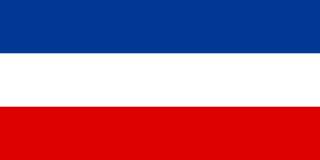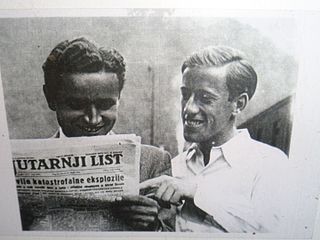
The Yugoslavia national football team represented Yugoslavia in international association football.

Serbia and Montenegro competed at the 2004 Summer Olympics in Athens, Greece, from 13 to 29 August 2004. Previously known as the Federal Republic of Yugoslavia, this was the nation's third and last joint appearance at the Summer Olympics before Serbia and Montenegro became separated independent states in 2006. The Olympic Committee of Serbia and Montenegro sent a total of 85 athletes to the Games, 78 men and 7 women, to compete in 14 sports. Men's basketball, football, volleyball, and water polo were the only team-based sports in which Serbia and Montenegro had its representation at these Games. There was only a single competitor in road cycling, judo, tennis, and wrestling.
The United States men's national tennis team represents the United States in Davis Cup tennis competition, and is governed by the United States Tennis Association.

National team appearances in the FIBA Basketball World Cup are the number of appearances that individual country's basketball national teams have made at the FIBA Basketball World Cup. A total of 65 countries have made at least one appearance in the FIBA international senior men's basketball competition.
The 1999 Davis Cup was the 88th edition of the Davis Cup, the most important tournament between national teams in men's tennis. 129 teams entered the competition, 16 in the World Group, 30 in the Americas Zone, 32 in the Asia/Oceania Zone, and 51 in the Europe/Africa Zone. Fiji made its first appearances in the tournament.
The 1995 Davis Cup was the 84th edition of the Davis Cup, the most important tournament between national teams in men's tennis. 115 teams entered the competition, 16 in the World Group, 25 in the Americas Zone, 29 in the Asia/Oceania Zone, and 45 in the Europe/Africa Zone. Bermuda, Ethiopia, Kazakhstan, Macedonia, Moldova and Pacific Oceania made their first appearances in the tournament.
The Montenegro Davis Cup team represents Montenegro in Davis Cup tennis competition and are governed by the Tennis Federation of Montenegro.
The 1993 Davis Cup was the 82nd edition of the Davis Cup, the most important tournament between national teams in men's tennis. 100 teams would enter the competition, 16 in the World Group, 22 in the Americas Zone, 23 in the Asia/Oceania Zone, and 39 in the Europe/Africa Zone. Benin, Croatia, the Czech Republic, Djibouti, Latvia, Russia, San Marino, Slovenia, Ukraine and the United Arab Emirates made their first appearances in the tournament.
The Serbian Billie Jean King Cup team represents Serbia in Billie Jean King Cup tennis competition and are governed by the Tennis Federation of Serbia. They will compete in 2019 Fed Cup Europe/Africa Zone Group I at Venue 1 in Bath, United Kingdom. From 5 June 2006, the team is playing under the name of Serbia.
The Yugoslavia Fed Cup team represented SFR Yugoslavia in Fed Cup tennis competition and was governed by the Yugoslav Tennis Association. With the dissolution of Yugoslavia, the team no longer exists.
Dragutin Mitić was a tennis player from Yugoslavia. He defected to the West in 1952 and afterwards lived in the United States.

Josip Palada was a Yugoslavian tennis player.

Franjo Punčec was a Yugoslav tennis player. He played for the Yugoslavian team at the International Lawn Tennis Challenge from 1933 to 1946.
The 2013 Davis Cup was the 102nd edition of the tournament between national teams in men's tennis. Czech Republic successfully held their place as Davis Cup champions, by defeating Serbia in the final, in Belgrade, by a 3–2 score. The draw took place on 19 September 2012 in London, United Kingdom. Although, the draws for Asia/Oceania Zone Group I and Europe/Africa Zone Group II were held following the remaining play-off ties on 19–21 October 2012.
The 2014 Davis Cup was the 103rd edition of the tournament between national teams in men's tennis. The final took place between the 21–23 of November 2014 in Lille, France, with Switzerland winning the title for the first time, defeating hosts France in the final.
Franjo Šefer was a Yugoslav tennis player of Austrian-Jewish descent.
The 2017 Davis Cup was the 106th edition of the Davis Cup, a tournament between national teams in men's tennis. It was sponsored by BNP Paribas. France won their tenth title, with Lucas Pouille defeating Steve Darcis of Belgium on indoor hard in the final match held at Stade Pierre-Mauroy located in Villeneuve-d'Ascq on 26 November.
The 2020–21 Davis Cup was the 109th edition of the Davis Cup, a tournament between national teams in men's tennis. It was sponsored by Rakuten. For this edition, the format of the cup was changed. The new format saw the creation of a Davis Cup World Group I and World Group II which was played on a worldwide basis and replaced the regional Group I and Group II. As a result, the Davis Cup nations ranking was no longer used to determine which group a nation was played in. Previous the 2019, and the 2021 finals host Spain were the defending champions. Due to the COVID-19 pandemic, on 26 June 2020 the ITF announced that the 2020 finals would take place from 22 until 28 November 2021. In addition, 24 World Group I and World Group II ties were postponed to March and September 2021, and the 2020 regional Group III and Group IV events were also postponed to 2021. The 18 nations that qualified for the finals kept their standing for the next year.
The Europe/Africa Zone was one of the three zones of the regional Davis Cup competition in 1993.
Milan Branović is a Croatian former tennis player.




